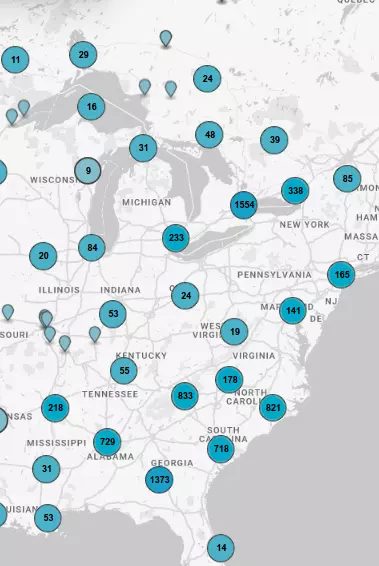THE SANTA FE TRAIL
THE SANTA FE TRAIL Cimarron, settled in 1878, got its name as the starting point at one time of the shorter Cimarron or dry route to Santa Fe. Here the Santa Fe divided, one branch heading...
- kshs
- kansas
GEODETIC CENTER OF NORTH AMERICA
GEODETIC CENTER OF NORTH AMERICA On a ranch 18 miles southeast of this marker a bronze plate marks the most important spot on this continent to surveyors and mapmakers. Engraved in the bronze is a...
- kshs
- kansas
OLD RUNNYMEDE
OLD RUNNYMEDE Two miles northeast of here , in 1890, stood a typical English village. Curving driveways led to English-style houses set among rows of clipped hedges. Nearby were polo grounds, a...
- kshs
- kansas
TURKEY RED WHEAT
TURKEY RED WHEAT Children in Russia hand-picked the first seeds of this famous winter wheat for Kansas. They belonged to Mennonite Colonies preparing to emigrate from the steppes to the America...
- kshs
- kansas
BATTLE OF THE SPURS
BATTLE OF THE SPURS One witness to this event later wrote that it was “no joke” to attack old John Brown. The abolitionist inspired such terror that in January 1859, about 1.5 miles north of here,...
- kshs
- kansas
BATTLE OF HICKORY POINT
BATTLE OF HICKORY POINT In September, 1856, a band of Proslavery men sacked Grasshopper Falls (Valley Falls) and terrorized the vicinity. On the 13th, the Free-State leader James H. Lane with a...
- kshs
- kansas
SANTA FE TRAIL RUTS 1821-1872
SANTA FE TRAIL RUTS 1821-1872 Looking east, up and over the bank of the ditch, one can see the wagon ruts of the Santa Fe Trail. You will notice a difference in the color and texture of the...
- kshs
- kansas
CANNONBALL STAGE LINE HIGHWAY
CANNONBALL STAGE LINE HIGHWAY Flamboyant and colorful, Donald R. 'Cannonball' Green (1839-1922) ran a stage line connecting the railroad to towns across southwestern Kansas. Green started...
- kshs
- kansas
FORT LEAVENWORTH
FORT LEAVENWORTH Established in 1827, Fort Leavenworth is the oldest army post in continuous operation west of the Missouri River. Serving as the army's chief base of operations on the...
- kshs
- kansas
LAWRENCE AND THE OLD TRAILS
LAWRENCE AND THE OLD TRAILS Between Lawrence and Topeka, the Kansas turnpike passes near the route of the old Oregon-California Trail, traveled in the 1800s by explorers, missionaries,...
- kshs
- kansas
OSAGE NATION
OSAGE NATION Originally from the Ohio Valley, the Osages agreed in 1810 to a treaty to relinquish lands in Missouri and relocate along the Neosho River in Kansas. Under the leadership of...
- kshs
- kansas
BATTLE OF MINE CREEK
BATTLE OF MINE CREEK In October, 1864, a Confederate Army under Gen. Sterling Price was defeated near Kansas City. He retreated south, crossed into Kansas, and camped at Trading Post. Early on the...
- kshs
- kansas
EMPORIA--HOME OF WILLIAM ALLEN WHITE
EMPORIA--HOME OF WILLIAM ALLEN WHITE When native- born William Allen White entered college at Emporia in 1884, the city, incorporated in 1857, already was called the Athens of Kansas because...
- kshs
- kansas
KANSAS INDIAN TREATY
KANSAS INDIAN TREATY In 1825 President James Monroe approved a bill providing for the survey of the Santa Fe Trail from Missouri to New Mexico and the making of treaties to insure...
- kshs
- kansas
THE MENNONITES IN KANSAS
THE MENNONITES IN KANSAS Beginning in 1874, hundreds of peace-loving Mennonite immigrants settled in central Kansas. They had left their former homes in Russia because a hundred-year-old immunity...
- kshs
- kansas
THE LANE TRAIL
THE LANE TRAIL Near here the towns of Plymouth and Lexington once stood as outposts on the Lane Trail, approximated today by US-75. Named for abolitionist James H. Lane, the trail was established...
- kshs
- kansas
ALCOVE SPRINGS AND THE OREGON TRAIL
ALCOVE SPRINGS AND THE OREGON TRAIL Six miles northwest is Alcove Springs, named in 1846 by appreciative travelers on the Oregon Trail who carved the name on the surrounding rocks and trees. One...
- kshs
- kansas
THE LONE TREE INCIDENT
THE LONE TREE INCIDENT In 1874 twenty-seven persons were murdered by Indians on the western frontier of Kansas. Several times during the summer warriors broke away from the restraint of their...
- kshs
- kansas
JOHN BROWN COUNTRY
JOHN BROWN COUNTRY Osawatomie - the name derives from a combination of Osage and Pottawatomie - was settled in 1854 by Free-State families from the Ohio Valley and New England. John Brown, soon...
- kshs
- kansas
WACONDA SPRINGS
WACONDA SPRINGS American Indians considered Waconda Springs a sacred site. Translated similarly by other tribes, the name comes from a Kaw word meaning “Great Spirit.” The legend tells of the...
- kshs
- kansas
